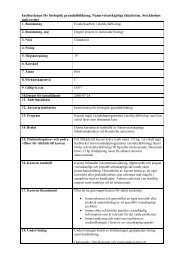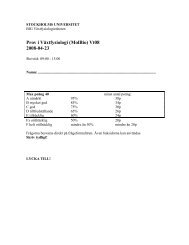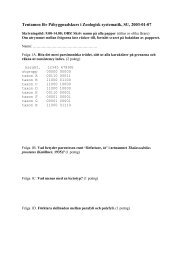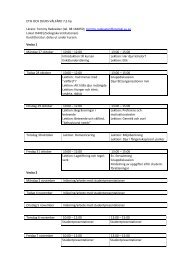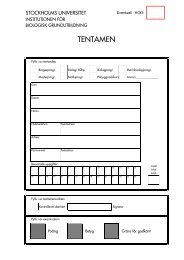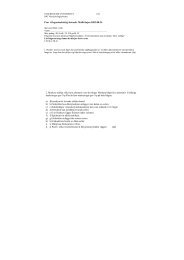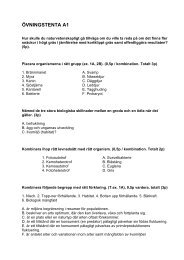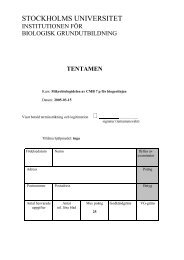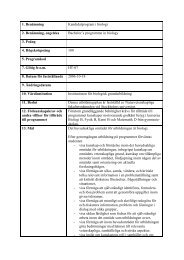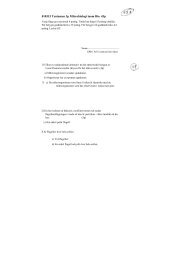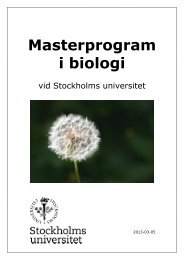Guidelines and Templates for Grading Criteria used in ... - BIG
Guidelines and Templates for Grading Criteria used in ... - BIG
Guidelines and Templates for Grading Criteria used in ... - BIG
You also want an ePaper? Increase the reach of your titles
YUMPU automatically turns print PDFs into web optimized ePapers that Google loves.
<strong>BIG</strong>’s <strong>Guidel<strong>in</strong>es</strong><br />
• <strong>Grad<strong>in</strong>g</strong> criteria are to be drawn up by the teacher responsible <strong>for</strong> the course <strong>in</strong><br />
collaboration with the director of studies.<br />
• A student must achieve pass grades <strong>for</strong> all parts of a course, <strong>in</strong> order to pass the course<br />
as a whole. If a course consists of several parts that are <strong>in</strong>dividually assessed on a<br />
seven-po<strong>in</strong>t scale, the overall grade <strong>for</strong> the course is to be set as specified by the rules<br />
<strong>in</strong> Appendix 1.<br />
• In cases <strong>in</strong> which the per<strong>for</strong>mance of students is measured as po<strong>in</strong>ts, the lower limits<br />
<strong>for</strong> the various grades will be as follows (expressed as percentages of the maximum<br />
po<strong>in</strong>ts available):<br />
A 95 %<br />
B 85 %<br />
C 75 %<br />
D 65 %<br />
E 60 %<br />
Fx 50 %<br />
F below 50 %<br />
• Both Fx <strong>and</strong> F are “Fail”, <strong>and</strong> the student must resit the complete exam<strong>in</strong>ation. This<br />
means, there<strong>for</strong>e, that the grade Fx is not to be regarded as “Approved, subject to<br />
supplementary work”. The concept of “supplement<strong>in</strong>g” a grade is not to be <strong>used</strong><br />
except <strong>in</strong> exceptional cases where exceptional cause can be shown.<br />
• <strong>BIG</strong> has published some templates <strong>for</strong> grad<strong>in</strong>g criteria (Appendix 2). These templates<br />
are <strong>in</strong>tended to be <strong>used</strong> <strong>for</strong> different types of course <strong>and</strong> different types of <strong>for</strong>m of<br />
exam<strong>in</strong>ation. Template 1 is <strong>in</strong>tended to be <strong>used</strong> <strong>for</strong> such practical laboratory exercises<br />
that are to be assessed solely as “Pass” or “Fail”. Template 2 is <strong>in</strong>tended to be <strong>used</strong> <strong>for</strong><br />
undergraduate courses that are exam<strong>in</strong>ed <strong>in</strong> the <strong>for</strong>m of a written exam<strong>in</strong>ation.<br />
Template 3 is <strong>in</strong>tended to be <strong>used</strong> <strong>in</strong> various course parts that are exam<strong>in</strong>ed by oral<br />
<strong>and</strong> written presentation, such as, <strong>for</strong> example, a student’s <strong>in</strong>dividual work, project<br />
work, essays <strong>and</strong> sem<strong>in</strong>ars. The template is not <strong>in</strong>tended <strong>for</strong> use with undergraduate<br />
project work or equivalent <strong>in</strong>dependent work. It is <strong>in</strong>tended that the templates function<br />
as aids <strong>and</strong> as sources of <strong>in</strong>spiration, <strong>and</strong> they can thus be modified or supplemented<br />
with criteria that are specific <strong>for</strong> a particular subject. It is also permissible to <strong>for</strong>mulate<br />
grad<strong>in</strong>g criteria <strong>in</strong> other ways.<br />
• Template 4 is <strong>in</strong>tended to be <strong>used</strong> <strong>for</strong> undergraduate project work or equivalent<br />
<strong>in</strong>dependent work. This template is more prescriptive that the other templates, s<strong>in</strong>ce<br />
the eight assessment grounds that are specified have been determ<strong>in</strong>ed by the faculty.<br />
They may not be changed. <strong>BIG</strong> has appo<strong>in</strong>ted a work<strong>in</strong>g group that is to draw up<br />
proposed common guidel<strong>in</strong>es <strong>for</strong> the weight<strong>in</strong>g of the assessment grounds dur<strong>in</strong>g the<br />
autumn term of 2007. Until these common guidel<strong>in</strong>es have been published, each<br />
<strong>in</strong>dividual department with<strong>in</strong> HUFO must determ<strong>in</strong>e how the assessment grounds are<br />
to be weighted <strong>for</strong> the degree projects that are to commence <strong>in</strong> the autumn term of<br />
2007.



